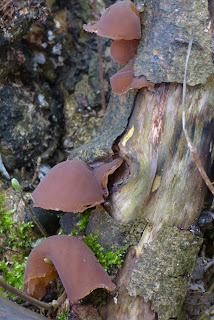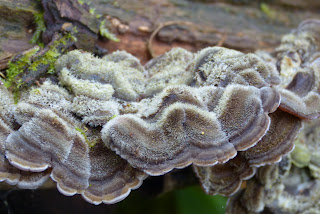Whilst we were exploring Eardington Quarry and its neighbouring woodland a couple of us came across a sight I would rather not see again. Earlier my colleague had spotted a deer in a field above where we were walking. Some time later we made our way into that field. and followed the path alongside the fence. After a while we saw a deer's leg trapped in the fence. It was only a few moments later that we realised that the deer was still alive.
What could we do? It had caught its leg between the top of the stock proof fence and the barbed-wire top strand and twisted the two together with its leg trapped between causing the wiring to tighten. It could not be untwisted by us.
What could we do? My companion went to summon help from the RSPCA or similar organisation whilst I stood guard trying not to spook the animal causing it more distress. Some time later my colleague returned with a pair of wire cutters and told me that Cuan Animal Rescue Centre had be contacted.
Do we wait or try to help. We decided to try to free the animal and used the wire cutter to cut one of the entangling strands. It took a lot of effort but eventually the wire was cut and instantly the deer took flight.
Regrettably it was clearly injured, as it ran, remarkably quickly, using only three legs with the leg that had been trapped stuck out at an angle.
Did we do the right thing? I do not know. But the distress of the animal was clear to see and it was impossible to stand by and not to do something.
Eight of us made the trip to Eardington Quarry Nature Reserve on a cold, breezy, damp, grey day. As we had been asked to look at their colony of the bee Colletes cunicularis and also their newly created "Bee Village" we had picked exactly the wrong day to visit. Apart from a few hardy bumble bees that we saw later in the day there was not a bee to be seen.
Erardington Quarry is a former sand and gravel quarry that was taken on by Shropshire County Council and turned with the help of a very enthusiastic Friends group the site into a nature reserve. One of their projects was to create a series of habitats likely to attract nesting bees.
The village consists of a series of sandy south facing banks, wooden poles with holes drilled in them, earth banks contained in washing machine drums, bee houses on posts and general scrub clear sandy soil. Here is a view of part of the village
Unfortunately the weather and lack of bees meant that we did not spend as much time here as we had intended.
In cold damp weather a vacuum sampler usually comes to our rescue and soon it was brought into use and its catch examined.
Meanwhile a younger person with younger eyes and reflexes managed to capture a Devil's coach-horse (Ocypus olens) our largest rove beetle.
 |
| Photograph: David Williams |
A reptile tile was lifted - no reptiles but lots of ants and some white woodlice.
 |
| Photograph: Ed Phillips |
 |
| Photograph: David Williams |
 |
| Photograph: Jim Cresswell |
 |
| Primrose |
 |
| Dog-violet |
 |
| Photograph: Jim Cresswell |
And elsewhere we were finding tripe.
Or more precisely - tripe fungus, which in a fungusy sort of way is very attractive.
 |
| Photograph: Jim Cresswell |
 |
| Photograph: Jim Cresswell |
Pill woodlouse - Armadillidium vulgare
 |
| Photograph: David Williams |
 |
| Photograph: David Williams |
 |
| Photograph: David Williams |
What?
Is that really easier to remember than its scientific name?
There was no convenient site for lunch other than the picnic tables in the reserve, which were wet, but, more pertinently, sited in the teeth of the arctic wind, so we lunched on the path passing through the woodland on a variety of barrels, tree stumps, the ground and even a portable stool.
Close to the lunch site a couple of springtails posed for photographs
Dicyrtoma fusca
 |
| Photograph: Ed Phillips |
 |
| Photograph: Ed Phillips |
 |
| Blackbird nest - Photograph: Jim Cresswell |
It was a little later that a couple of us tried to explore further into the valley that the incident of the deer occurred. This took the gloss off the day and we decided to return to the quarry then make our way home.
From there we moved on to a meadow area where we collected a gatekeeper butterfly larva
 |
| Photograph: David Williams |
My thanks to Shropshire County Council for giving us permission to do what we enjoy doing and the Friends of Eardington Quarry for showing us around the bee village. Thank you also to the photographers Jim Cresswell, Ed Phillips and David Williams for letting me use their excellent photographs to supplement my own efforts.































No comments:
Post a Comment
Please feel free to comment on this post...